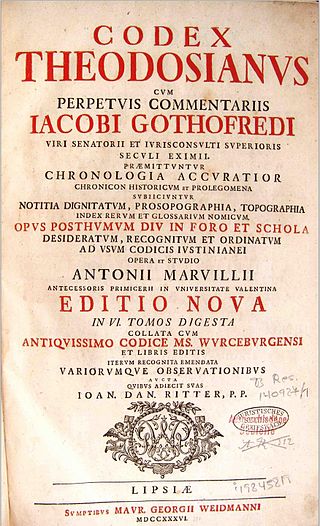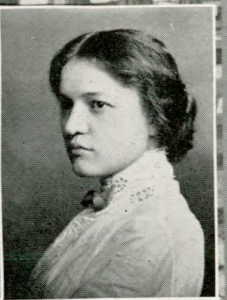Related Research Articles

The Corpus JurisCivilis is the modern name for a collection of fundamental works in jurisprudence, enacted from 529 to 534 by order of Byzantine Emperor Justinian I. It is also sometimes referred to metonymically after one of its parts, the Code of Justinian.

The Digest, also known as the Pandects, was a compendium or digest of juristic writings on Roman law compiled by order of the Byzantine emperor Justinian I in 530–533 AD. It is divided into 50 books.

Civil law is a legal system originating in Italy and France that has been adopted in large parts of the world. Modern civil law stems mainly from the Napoleonic Code of the early 19th century, and it is a continuation of ancient Roman law. Its core principles are codified into a referable system, which serves as the primary source of law.

The Codex Theodosianus is a compilation of the laws of the Roman Empire under the Christian emperors since 312. A commission was established by Emperor Theodosius II and his co-emperor Valentinian III on 26 March 429 and the compilation was published by a constitution of 15 February 438. It went into force in the eastern and western parts of the empire on 1 January 439. The original text of the codex is also found in the Breviary of Alaric, promulgated on 2 February 506.

Wilbur Monroe Leaf was an American writer of children's literature who wrote and illustrated nearly 40 books during his 40-year career. He is best known for The Story of Ferdinand (1936), a children's classic which he wrote on a yellow legal-length pad in less than an hour. Labeled as subversive, it stirred an international controversy.

Byzantine law was essentially a continuation of Roman law with increased Orthodox Christian and Hellenistic influence. Most sources define Byzantine law as the Roman legal traditions starting after the reign of Justinian I in the 6th century and ending with the Fall of Constantinople in the 15th century. Although future Byzantine codes and constitutions derived largely from Justinian's Corpus Juris Civilis, their main objectives were idealistic and ceremonial rather than practical. Following Hellenistic and Near-Eastern political systems, legislations were tools to idealize and display the sacred role and responsibility of the emperor as the holy monarch chosen by God and the incarnation of law "nómos émpsychos", thus having philosophical and religious purposes that idealized perfect Byzantine kingship.
Fred Heinrich Blume, or Fred H. Blume, as he referred to himself, was a German-born American attorney and judge. He served as a justice of the Wyoming Supreme Court for 42 years, from 1922 to 1963, and by himself translated from Latin into English the Codex Justinianus and the Novels, two parts of the Corpus Juris Civilis.
Jews were numerous and had significant roles throughout the history of the Byzantine Empire.
The Annual Bulletin of the Comparative Law Bureau of the American Bar Association (ABA) was a U.S. specialty law journal. The first comparative law journal in the United States, it surveyed foreign legislation and legal literature. Circulated to all ABA members, it was absorbed in 1915 by the newly formed American Bar Association Journal.
The Novellae Constitutiones, or Justinian's Novels, are now considered one of the four major units of Roman law initiated by Roman emperor Justinian I in the course of his long reign. The other three pieces are: the Codex Justinianus, the Digest, and the Institutes. Justinian's quaestor Tribonian was primarily responsible for compiling these last three. Together, the four parts are known as the Corpus Juris Civilis. Whereas the Code, Digest, and Institutes were designed by Justinian as coherent works, the Novels are diverse laws enacted after 534 that never were officially compiled during his reign.

Charles Sumner Lobingier was an American jurist who served as a judge of the Philippine Court of First Instance from 1904 to 1914 and as Judge of the United States Court for China in Shanghai from 1914 to 1924. He was also the author of a number of books on international and comparative law.

Samuel Parsons Scott, known as S. P. Scott, was an American attorney, banker and scholar. He was born in Hillsboro, Ohio, where he received a classics-based education at the Hillsboro Academy; he went on to earn his A.B. degree from the Miami University in 1868, was elected to Phi Beta Kappa, and obtained his A.M. degree from the same institution the following year. Scott was licensed to practice law in 1868 and was an attorney for several years in Leavenworth, Kansas and in San Francisco, but he left the practice of law in 1875 to return to Hillsboro and the family banking business. Thereafter, he also traveled in Europe, studied, and wrote. Late in his life, he served for many years on the editorial staff of the American Bar Association's Comparative Law Bureau.

The Institutes is a component of the Corpus Juris Civilis, the 6th-century codification of Roman law ordered by the Byzantine emperor Justinian I. It is largely based upon the Institutes of Gaius, a Roman jurist of the second century A.D. The other parts of the Corpus Juris Civilis are the Digest, the Codex Justinianus, and the Novellae Constitutiones.

The Code of Justinian is one part of the Corpus Juris Civilis, the codification of Roman law ordered early in the 6th century AD by Justinian I, who was Eastern Roman emperor in Constantinople. Two other units, the Digest and the Institutes, were created during his reign. The fourth part, the Novellae Constitutiones, was compiled unofficially after his death but is now also thought of as part of the Corpus Juris Civilis.
Charles Phineas Sherman was a professor of Roman law and canon law at several colleges, including the Yale Law School, the College of William and Mary, and the Boston University School of Law. He wrote many articles and books, of which the best known is Roman Law in the Modern World.
The Sirmondian Constitutions are a collection of sixteen Imperial Codes passed between AD 333 and 425, dealing with "bishops courts", or laws dealing with church matters. They take their name from their first editor, Jacques Sirmond. Some of the laws appeared in abbreviated form in the Theodosian Code. The full collection survives only in a single early medieval manuscript now in Berlin, termed the Codex Lugdunensis.
The Tascodrugites were a sect active in Galatia in the fourth and fifth centuries AD, and possibly as late as the ninth. Ancient sources present them variously as Gnostics or heterodox Christians. Most likely they were Montanists.

Theresa Julienna Sherrer Davidson was an American classicist, lawyer, law librarian, and artist.
William Sims Thurman was a classicist whose major contribution to scholarship is his English translation of Justinian's Thirteen Edicts. Thurman was born in Paris, but he lived much of his life in Asheville, North Carolina where he taught at the University of North Carolina at Asheville.
Mary Brown Pharr was an American classicist, best known for her work with her husband Clyde Pharr on the translation of the Codex Theodosianus.
References
- ↑ New York, Passenger Lists, 1820-1957
- ↑ World War I Draft Registration Cards, 1917-1918
- ↑ U.S. Passport Applications, 1795-1925
- ↑ See Biographical Dictionary of North American Classicists 498 (Ward W. Briggs Jr., ed., 1974), and Linda Jones Hall, "Clyde Pharr, the Women of Vanderbilt, and the Wyoming Judge: The Story behind the Translation of the Theodosian Code in Mid-Century America," 8 Roman Legal Tradition 1, 3 (2012)
- ↑ For references to the history of East Texas Normal College, and of the normal school generally, see Timothy G. Kearley, "From Rome to the Restatement: S.P. Scott, Fred Blume, Clyde Pharr, and Roman Law in Early Twentieth-Century America," 108 Law Libr. J. 55, note 136 at 72 (2016), available at . See also Samuel Parsons Scott in Wikipedia.
- ↑ See "Biographical Dictionary" supra note 2.
- ↑ Biographical Dictionary, supra note 2
- ↑ Id.
- ↑ Hall, supra note 2 at 2. Revised versions of "Homeric Greek," and "Aeneid I-VI" are still in print.
- ↑ The Theodosian Code and Novels and the Sirmondian Constitutions (1952). For a detailed description of the project, see generally Hall, supra note 2. See also, Timothy Kearley, "Justice Fred Blume and the Translation of Justinian's Code," 99 Law Library Journal 525 (2007), and Fred H. Blume in Wikipedia.
- ↑ "Marriage of Brown/Pharr, The Tennessean, Nov.11, 1945, p.29.
- ↑ Biographical Dictionary, supra note 2.
- ↑ See, e.g., Reginald Parker, "Book Review," 6 Vanderbilt Law Review 965 (1953) and Leonard Oppenheim, "Book Review",27 Tulane Law Review 501 (1953). See generally Timothy G. Kearley, Roman Law, Classical Education, and Limits on Classical Participation in America into the Twentieth-Century 210-212 (2022).
- ↑ A translation of the Justinian Code, based Justice Blume's was published in 2016. The Codex of Justinian: A New Annotated Translation, with Parallel Latin and Greek Text, Based on a Translation by Justice Fred H. Blume (Bruce W. Frier ed., 2016).
- ↑ This series was to consist of: 1) Bruns, "Fontes Iuris Romani Antiqui"; 2) other inscriptional material; 3) the pre-Justinian collections of Roman jurisprudence; 4) the Theodosian Code and novels; 5) other pre-Justinian legislation; 6) the Corpus Juris Civilis; 7) the most important legal materials culled from classical authors such as Cicero, Pliny and Aulus Gellius; and 8) papyri material. Kearley, supra note 9 at 537, note 7.
- ↑ Clyde Pharr, with Theresa Davidson and Mary Brown Pharr, The Theodosian Code and Novels and the Sirmonidean Constitutions (1952); and Alan Chester Johnson, Paul Robinson Coleman-Norton and Frank Carl Bourne, Ancient Roman Statutes (1961).
- ↑ Thurman, W. S. The Thirteen Edicts of Justinian; Translated and Annotated by William Sims Thurman. [University of Texas PhD dissertation; ProQuest Dissertations & Theses](1964).
- ↑ "Professor Emeritus at UT Dies". The Austin American. Austin, Texas. January 1, 1973. Retrieved July 18, 2018.
- ↑ "Mrs. Mary Pharr". The Austin American. Austin, Texas. December 26, 1972. p. 28. Retrieved July 18, 2018.